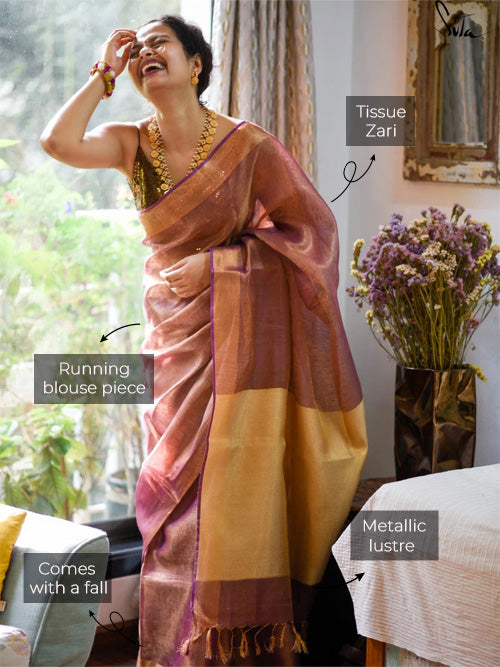
Gar-2668 GARAGE_SAREE
40% off
Kindly empty your cart to purchase a Suta product OR checkout with the existing Relove products of your cart and then, shop Suta products.
Free shipping on domestic orders above Rs. 1,950
2-7 days delivery within India
No Return & No Exchange On This Item.
Cash on delivery is available
Product Type: garage_saree
Length: 5.50 m (550.00 cm) ; Width: 1.19 m (119.38 cm)
Blouse Piece: No
Wash Care: Dry Wash
Note: The mannequin is wearing a blouse called Basic Safed.
Underskirt: You can pair it with a Black underskirt.
Fabric: Mul Cotton
Defect: Torn On Selvedge In Middle Portion Of Saree
Disclaimer: The pictures are clicked in daylight. Color may vary slightly from the image due to the screen brightness.
Note: Suta Garage sarees may or may not have fall and edging.
What You will Receive: 1 garage_saree
SKU: SUTAGRG5632
No matter how much we move forward in time, it is often our very roots that hold us in place. As far as our fabrics are concerned, we are in an age of constant innovation and up-gradation. Even so, our love for age-old crafts and processes like block printing can never fade. Block printing is an art that is at least a few centuries old. Especially in India, the art has evolved to incorporate the motifs and designs of different regions. It is a process of printing designs on a base fabric using wooden stamps dipped in dye. The charm lies in the fact that all the steps of block printing are done by artisans using their hands. Right from carving the wooden stamp, which itself requires a lot of expertise and skill, to printing the fabric and drying it, each step is carried out by dedicated artisans. The intricately carved stamps are a wonder by themselves and there are separate sects of artisans who specialise in this and create highly nuanced wooden stamps using chisels, drills and hammers. Once this is done, mustard oil is applied to the stamps and they are left to soak up the oil to prevent cracks. Meanwhile, the base fabric is washed and dyed. Handloom fabrics are most preferred as they absorb the colours of the print gorgeously. Following this, the fabric is laid out on a flat surface and held in place with small pins. What makes this fabric special is the almost magical process of weaving it. Cotton fibres are separated and spun into strong threads. The lightest and the most delicate fibres are separated and are then spun into muslin thread. These are then woven into fabrics by skilled weavers. The history of muslin weaving is a beautiful chapter in the history of Indian textiles. The process of the yore was much more complex and involved many unique tools that look primitive but worked like magic. The upper jaw of a catfish was used to initially clean the cotton before spinning. To separate the lightest fibres, a Dhunkar (a bamboo bow) was used, which when strung in a distinctive way made the lighter fibres rise above the heavier ones. This process gave the title ˜woven air to the muslin fabric.wooden stamp is dipped in the chosen dye and then slammed onto the fabric in one forceful motion. The entire saree or as much as required is printed this way by consecutively pressing the stamp on the fabric with force. After the process is over, the saree is washed and dried. The patience, skill and creativity of artisans come forth brilliantly with a hand block printed saree. There are bound to be small irregularities in the print as a result of human error and that lends a whole new level of allure to this art-form.
The block-printing on this saree is done on a made-in-heaven mul cotton fabric which is lighter than air and loved by our Suta Queens immensely.
The mul cotton is what we call ˜made in heaven at Suta. Known in West Bengal as mul mul, the fabric is what can be categorised as muslin cotton. It is believed that this fine method of weaving cotton can be traced back to even before the Indus valley civilization.
Country of Origin: India
Packed By: Suta Pvt. Ltd.
Registered Address: Om ShivAmbika Co-Op Hsg Soc, Kalina, Santacruz East, Mumbai-400098
No returns or exchange applicable on Suta Garage products
Choose options

Gar-2668 GARAGE_SAREE
40% off

















